David Alvarez-Melis
Boomerang Distillation Enables Zero-Shot Model Size Interpolation
Oct 06, 2025Abstract:Large language models (LLMs) are typically deployed under diverse memory and compute constraints. Existing approaches build model families by training each size independently, which is prohibitively expensive and provides only coarse-grained size options. In this work, we identify a novel phenomenon that we call boomerang distillation: starting from a large base model (the teacher), one first distills down to a small student and then progressively reconstructs intermediate-sized models by re-incorporating blocks of teacher layers into the student without any additional training. This process produces zero-shot interpolated models of many intermediate sizes whose performance scales smoothly between the student and teacher, often matching or surpassing pretrained or distilled models of the same size. We further analyze when this type of interpolation succeeds, showing that alignment between teacher and student through pruning and distillation is essential. Boomerang distillation thus provides a simple and efficient way to generate fine-grained model families, dramatically reducing training cost while enabling flexible adaptation across deployment environments. The code and models are available at https://github.com/dcml-lab/boomerang-distillation.
Can Interpretation Predict Behavior on Unseen Data?
Jul 08, 2025Abstract:Interpretability research often aims to predict how a model will respond to targeted interventions on specific mechanisms. However, it rarely predicts how a model will respond to unseen input data. This paper explores the promises and challenges of interpretability as a tool for predicting out-of-distribution (OOD) model behavior. Specifically, we investigate the correspondence between attention patterns and OOD generalization in hundreds of Transformer models independently trained on a synthetic classification task. These models exhibit several distinct systematic generalization rules OOD, forming a diverse population for correlational analysis. In this setting, we find that simple observational tools from interpretability can predict OOD performance. In particular, when in-distribution attention exhibits hierarchical patterns, the model is likely to generalize hierarchically on OOD data -- even when the rule's implementation does not rely on these hierarchical patterns, according to ablation tests. Our findings offer a proof-of-concept to motivate further interpretability work on predicting unseen model behavior.
Guided Speculative Inference for Efficient Test-Time Alignment of LLMs
Jun 04, 2025Abstract:We propose Guided Speculative Inference (GSI), a novel algorithm for efficient reward-guided decoding in large language models. GSI combines soft best-of-$n$ test-time scaling with a reward model $r(x,y)$ and speculative samples from a small auxiliary model $\pi_S(y\mid x)$. We provably approximate the optimal tilted policy $\pi_{\beta,B}(y\mid x) \propto \pi_B(y\mid x)\exp(\beta\,r(x,y))$ of soft best-of-$n$ under the primary model $\pi_B$. We derive a theoretical bound on the KL divergence between our induced distribution and the optimal policy. In experiments on reasoning benchmarks (MATH500, OlympiadBench, Minerva Math), our method achieves higher accuracy than standard soft best-of-$n$ with $\pi_S$ and reward-guided speculative decoding (Liao et al., 2025), and in certain settings even outperforms soft best-of-$n$ with $\pi_B$. The code is available at https://github.com/j-geuter/GSI .
Decomposing Elements of Problem Solving: What "Math" Does RL Teach?
May 28, 2025Abstract:Mathematical reasoning tasks have become prominent benchmarks for assessing the reasoning capabilities of LLMs, especially with reinforcement learning (RL) methods such as GRPO showing significant performance gains. However, accuracy metrics alone do not support fine-grained assessment of capabilities and fail to reveal which problem-solving skills have been internalized. To better understand these capabilities, we propose to decompose problem solving into fundamental capabilities: Plan (mapping questions to sequences of steps), Execute (correctly performing solution steps), and Verify (identifying the correctness of a solution). Empirically, we find that GRPO mainly enhances the execution skill-improving execution robustness on problems the model already knows how to solve-a phenomenon we call temperature distillation. More importantly, we show that RL-trained models struggle with fundamentally new problems, hitting a 'coverage wall' due to insufficient planning skills. To explore RL's impact more deeply, we construct a minimal, synthetic solution-tree navigation task as an analogy for mathematical problem-solving. This controlled setup replicates our empirical findings, confirming RL primarily boosts execution robustness. Importantly, in this setting, we identify conditions under which RL can potentially overcome the coverage wall through improved exploration and generalization to new solution paths. Our findings provide insights into the role of RL in enhancing LLM reasoning, expose key limitations, and suggest a path toward overcoming these barriers. Code is available at https://github.com/cfpark00/RL-Wall.
Causal integration of chemical structures improves representations of microscopy images for morphological profiling
Apr 13, 2025Abstract:Recent advances in self-supervised deep learning have improved our ability to quantify cellular morphological changes in high-throughput microscopy screens, a process known as morphological profiling. However, most current methods only learn from images, despite many screens being inherently multimodal, as they involve both a chemical or genetic perturbation as well as an image-based readout. We hypothesized that incorporating chemical compound structure during self-supervised pre-training could improve learned representations of images in high-throughput microscopy screens. We introduce a representation learning framework, MICON (Molecular-Image Contrastive Learning), that models chemical compounds as treatments that induce counterfactual transformations of cell phenotypes. MICON significantly outperforms classical hand-crafted features such as CellProfiler and existing deep-learning-based representation learning methods in challenging evaluation settings where models must identify reproducible effects of drugs across independent replicates and data-generating centers. We demonstrate that incorporating chemical compound information into the learning process provides consistent improvements in our evaluation setting and that modeling compounds specifically as treatments in a causal framework outperforms approaches that directly align images and compounds in a single representation space. Our findings point to a new direction for representation learning in morphological profiling, suggesting that methods should explicitly account for the multimodal nature of microscopy screening data.
To Backtrack or Not to Backtrack: When Sequential Search Limits Model Reasoning
Apr 09, 2025

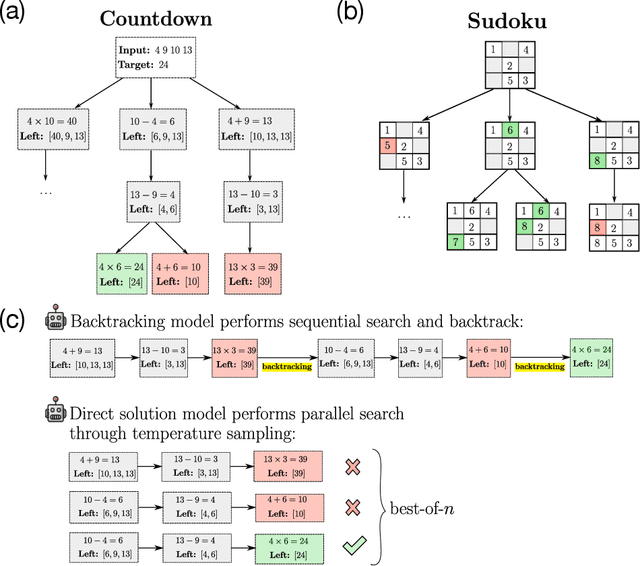
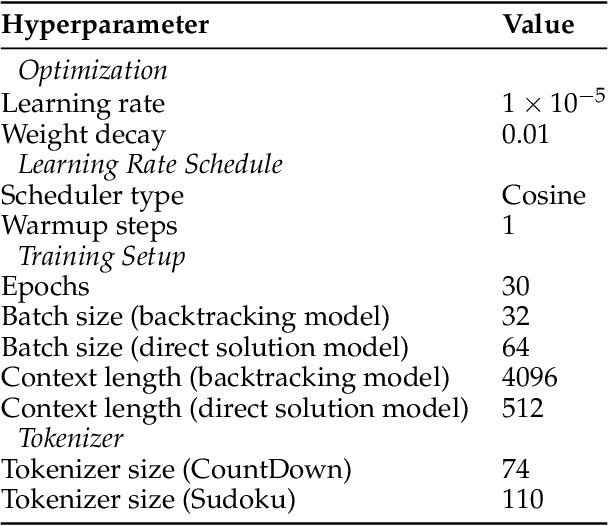
Abstract:Recent advancements in large language models have significantly improved their reasoning abilities, particularly through techniques involving search and backtracking. Backtracking naturally scales test-time compute by enabling sequential, linearized exploration via long chain-of-thought (CoT) generation. However, this is not the only strategy for scaling test-time compute: parallel sampling with best-of-n selection provides an alternative that generates diverse solutions simultaneously. Despite the growing adoption of sequential search, its advantages over parallel sampling--especially under a fixed compute budget remain poorly understood. In this paper, we systematically compare these two approaches on two challenging reasoning tasks: CountDown and Sudoku. Surprisingly, we find that sequential search underperforms parallel sampling on CountDown but outperforms it on Sudoku, suggesting that backtracking is not universally beneficial. We identify two factors that can cause backtracking to degrade performance: (1) training on fixed search traces can lock models into suboptimal strategies, and (2) explicit CoT supervision can discourage "implicit" (non-verbalized) reasoning. Extending our analysis to reinforcement learning (RL), we show that models with backtracking capabilities benefit significantly from RL fine-tuning, while models without backtracking see limited, mixed gains. Together, these findings challenge the assumption that backtracking universally enhances LLM reasoning, instead revealing a complex interaction between task structure, training data, model scale, and learning paradigm.
DDEQs: Distributional Deep Equilibrium Models through Wasserstein Gradient Flows
Mar 03, 2025Abstract:Deep Equilibrium Models (DEQs) are a class of implicit neural networks that solve for a fixed point of a neural network in their forward pass. Traditionally, DEQs take sequences as inputs, but have since been applied to a variety of data. In this work, we present Distributional Deep Equilibrium Models (DDEQs), extending DEQs to discrete measure inputs, such as sets or point clouds. We provide a theoretically grounded framework for DDEQs. Leveraging Wasserstein gradient flows, we show how the forward pass of the DEQ can be adapted to find fixed points of discrete measures under permutation-invariance, and derive adequate network architectures for DDEQs. In experiments, we show that they can compete with state-of-the-art models in tasks such as point cloud classification and point cloud completion, while being significantly more parameter-efficient.
Distributional Scaling Laws for Emergent Capabilities
Feb 24, 2025Abstract:In this paper, we explore the nature of sudden breakthroughs in language model performance at scale, which stands in contrast to smooth improvements governed by scaling laws. While advocates of "emergence" view abrupt performance gains as capabilities unlocking at specific scales, others have suggested that they are produced by thresholding effects and alleviated by continuous metrics. We propose that breakthroughs are instead driven by continuous changes in the probability distribution of training outcomes, particularly when performance is bimodally distributed across random seeds. In synthetic length generalization tasks, we show that different random seeds can produce either highly linear or emergent scaling trends. We reveal that sharp breakthroughs in metrics are produced by underlying continuous changes in their distribution across seeds. Furthermore, we provide a case study of inverse scaling and show that even as the probability of a successful run declines, the average performance of a successful run continues to increase monotonically. We validate our distributional scaling framework on realistic settings by measuring MMLU performance in LLM populations. These insights emphasize the role of random variation in the effect of scale on LLM capabilities.
IGDA: Interactive Graph Discovery through Large Language Model Agents
Feb 24, 2025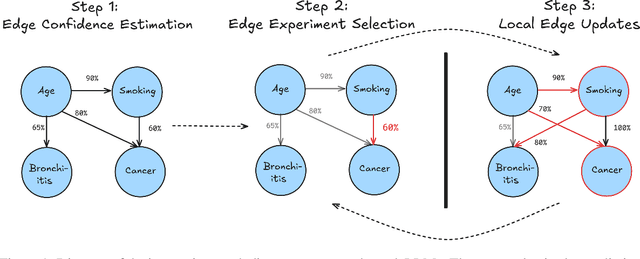
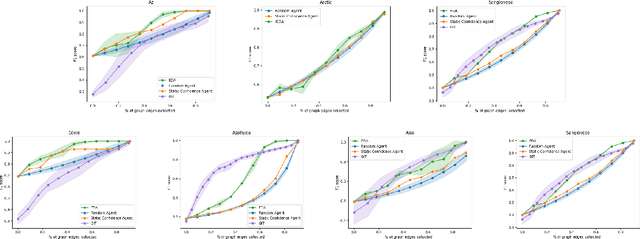
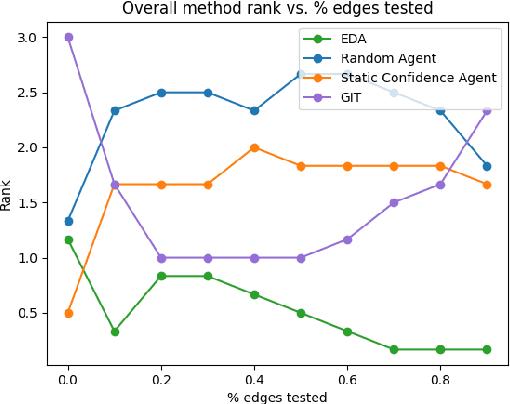
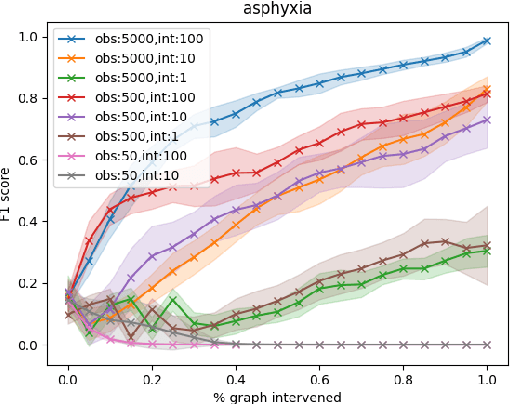
Abstract:Large language models ($\textbf{LLMs}$) have emerged as a powerful method for discovery. Instead of utilizing numerical data, LLMs utilize associated variable $\textit{semantic metadata}$ to predict variable relationships. Simultaneously, LLMs demonstrate impressive abilities to act as black-box optimizers when given an objective $f$ and sequence of trials. We study LLMs at the intersection of these two capabilities by applying LLMs to the task of $\textit{interactive graph discovery}$: given a ground truth graph $G^*$ capturing variable relationships and a budget of $I$ edge experiments over $R$ rounds, minimize the distance between the predicted graph $\hat{G}_R$ and $G^*$ at the end of the $R$-th round. To solve this task we propose $\textbf{IGDA}$, a LLM-based pipeline incorporating two key components: 1) an LLM uncertainty-driven method for edge experiment selection 2) a local graph update strategy utilizing binary feedback from experiments to improve predictions for unselected neighboring edges. Experiments on eight different real-world graphs show our approach often outperforms all baselines including a state-of-the-art numerical method for interactive graph discovery. Further, we conduct a rigorous series of ablations dissecting the impact of each pipeline component. Finally, to assess the impact of memorization, we apply our interactive graph discovery strategy to a complex, new (as of July 2024) causal graph on protein transcription factors, finding strong performance in a setting where memorization is impossible. Overall, our results show IGDA to be a powerful method for graph discovery complementary to existing numerically driven approaches.
Sometimes I am a Tree: Data Drives Unstable Hierarchical Generalization
Dec 05, 2024Abstract:Neural networks often favor shortcut heuristics based on surface-level patterns. As one example, language models (LMs) behave like n-gram models early in training. However, to correctly apply grammatical rules, LMs must rely on hierarchical syntactic representations instead of n-grams. In this work, we use cases studies of English grammar to explore how latent structure in training data drives models toward improved out-of-distribution (OOD) generalization.We then investigate how data composition can lead to inconsistent OOD behavior across random seeds and to unstable training dynamics. Our results show that models stabilize in their OOD behavior only when they fully commit to either a surface-level linear rule or a hierarchical rule. The hierarchical rule, furthermore, is induced by grammatically complex sequences with deep embedding structures, whereas the linear rule is induced by simpler sequences. When the data contains a mix of simple and complex examples, potential rules compete; each independent training run either stabilizes by committing to a single rule or remains unstable in its OOD behavior. These conditions lead `stable seeds' to cluster around simple rules, forming bimodal performance distributions across seeds. We also identify an exception to the relationship between stability and generalization: models which memorize patterns from low-diversity training data can overfit stably, with different rules for memorized and unmemorized patterns. Our findings emphasize the critical role of training data in shaping generalization patterns and how competition between data subsets contributes to inconsistent generalization outcomes across random seeds. Code is available at https://github.com/sunnytqin/concept_comp.git.
 Add to Chrome
Add to Chrome Add to Firefox
Add to Firefox Add to Edge
Add to Edge